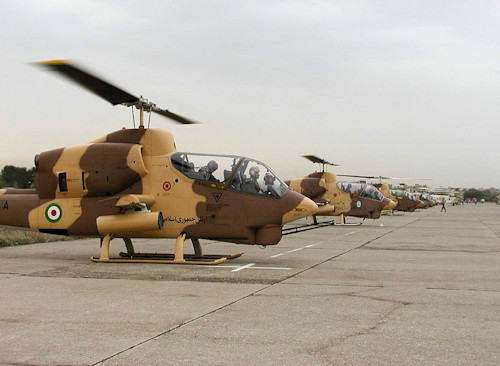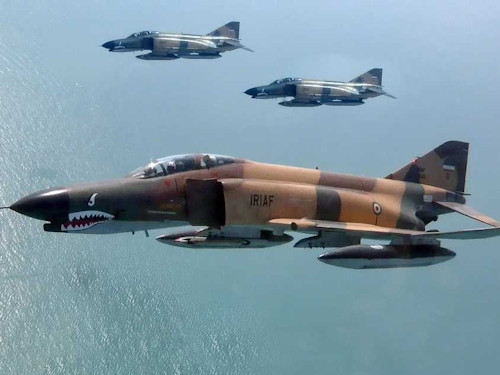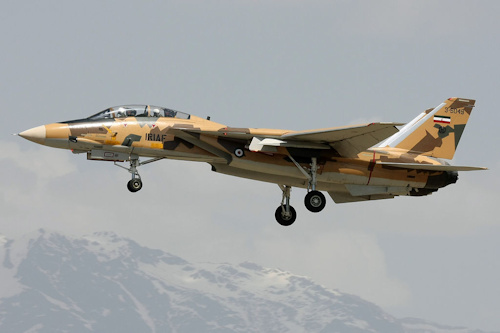In September 1980 the Iranian armed forces were only a shadow of what were the former imperial armies of the Shah. Only half of the arsenal was usable and most of the spare parts for the vehicles had to be cannibalized.
The situation was also dramatic in terms of personnel: many imperial top officials had been killed, jailed or fled abroad. The same could easily be said for many technical executives, including pilots. Thus only the young soldiers with little operational experience remained available to the new Islamic Republic of Iran.
From the organizational point of view, the Iranian Army was structured, on the eve of the conflict with Iraq, on three divisions and two armored brigades, four divisions and two mechanized brigades, two brigades of infantry and commando, plus five brigades of ' artillery. All units that, however, were heavily understaffed compared to the time of the Shah.
The 16 armored division was spread over three brigades in the Ghazvin-Znjan-Hamedan sector with the M-60 A1 wagons and the APC M-113. The 81 armored division, however, was risky in the province of Kermanshah and was also based on three brigades, but equipped with tanks Chieftain instead of the M-60 A1.

The defense of the strategic area of Khuzestan on which Saddam's lightning war should focus was finally entrusted to the 92 division - always mounted on Chieftain and M-113 - reinforced by the 283 ° armored cavalry battalion with APCs equipped with TOW anti-tank missiles.
The two formations cited were linked together by the 84 ° infantry brigade stationed in Khoramabad and the artillery brigades No. 22 and 55 °.
Teheran was defended by the 21 ° mechanized division which, in reality, was a sort of small corps being formed by the 2 ° Brigade Guards, the 1 ° infantry division, the 141 ° autonomous battalion, as well as aliquots of the dissolved 1 ° division of the Guard. At his side was present in the capital of Iran the 23 ° Brigade Special Forces, arranged on the eve of the conflict in different areas of the border with Iraq.
In the Sanandaj-Mahabad-Piransahr-Salmas triangle the 28 ° mechanized division was dislocated with a brigade wagons equipped on M-60 wagons and two mechanized brigades on M-113, plus an armored cavalry regiment exploring on light wagons Scorpion and other M-113. The 64 ° infantry division in the sector of Oromiyeh-Mahabad-Piransahr-Salmas was thought to assist the aforementioned unit, although it was largely incomplete.
The 77 ° mechanized division, on the border with the USSR and Afghanistan, could count on a brigade with old M-47 and two brigades on M-113. Connected with this were the Shiraz 37 ° armored brigade and the 88 ° Zehedan wagons on Chieftain. In Shiraz there was also the 55 ° brigade paratroopers with several detachments. The 30 ° brigade was finally located in Goirgan.
 Like the Iraqi Army, even the Iranian one could count on its own air component, albeit strongly weakened by the Western embargo to which the Ayatollah country was subjected.
Like the Iraqi Army, even the Iranian one could count on its own air component, albeit strongly weakened by the Western embargo to which the Ayatollah country was subjected.
In the 1980 it was organized into three operational regiments. The first was located in Kermanshah and was equipped with AB-205 / 206, Bell 214 and Cobra attack. The second one was instead located in Esfahan and had the same equipment as the previously illustrated department, but moreover it could count on the 4 ° heavy transport group on CH-47. Finally, the third party was based in Kerman.
Outside the regular army there were several other armed military formations to fill the gaps left by the revolution. These units were mostly made up of young and enthusiastic supporters of the Khomeinist Revolution. Although armed only with individual light weapons, the formations Pasdaran, Basij and Mostafazin - all gathered under the Command of the Revolutionary Guard starting from 1 January 1981 - soon became a real counterweight to the regular Iranian Army both on the battlefield and on the political level.
In second place, the Air Force was found to be important in the armed forces, which the new regime had renamed the Islamic Republic of Iran Air Force (IRIAF). Even though many of his aircraft were on the ground due to lack of spare parts and adequate maintenance, they still remained a respectable force.
 In Teheran the 1 ° aerobrigata was located with several flocks. These were: the 11 ° flock structured on two squadrons equipped with F-4E Phantom and RF-4E; the 1 ° mixed recon / ELINT flock on EC-130E, RF-4E and RF-5A; the air transport flock equipped with C-130 R / H, Tanker Boeing 707, Jumbo 747, Fokker-27 and various helicopters and finally the training flock on Beech F-33 and T-33 reactors.
In Teheran the 1 ° aerobrigata was located with several flocks. These were: the 11 ° flock structured on two squadrons equipped with F-4E Phantom and RF-4E; the 1 ° mixed recon / ELINT flock on EC-130E, RF-4E and RF-5A; the air transport flock equipped with C-130 R / H, Tanker Boeing 707, Jumbo 747, Fokker-27 and various helicopters and finally the training flock on Beech F-33 and T-33 reactors.
In Tabriz the 2 ° aerobrigata on a hunting flock and another COIN were located instead. The aircraft destined to operate with this great air unit were the F-5 in the different versions E and F, as well as the light O-2A for the Counter Insurgery together with the Bell 214 helicopters.
Near Hamedan was located the 3rd aerobrigata with the 31st flock - on F-4E fighter-bombers and Bell 214 helicopters - and the 32nd also on F-4, also present in the older version D.
At the "Vahdati" air base near Dezful there was the 4 ° aerobrigata with the 41 ° flock entirely mounted on F-5E / F. The departments of this training were reinforced in November 1980 with Tiger e Phantom coming from other aerobatics.
If the 5 ° Aaerobrigata was still placed in a square position on the eve of the conflict with Iraq, so could not be said for the 6 ° stationed in Bushehr with the flocks 61 ° and 62 ° mounted, respectively, on F-4E and C-130H, in addition to the helicopter support group.
The 7 ° aerobatized was located in Shiraz on the Hor air base, with the 71 ° combat flock and the 71 ° transport flock. The first department was armed with F-4E fighter-bombers as well as powerful Tomcat F-14A framed in the 72 ° and 73 ° squadron. The 71 ° transport storm framed, on the contrary, Hercules, Fokker F.27M, support helicopters, and P-3C air-sea patrol boats Orion framed in a special ad hoc department.
 In Esfahan the 8 ° aerobrigata was stationed with the 81 ° flock on F-14A plus Bell 214 on the back, while Bandar Abbas was the 9 ° aerobatized with flocks equipped exclusively on F-4E armed with missiles bullpup. Finally, to complete the aeronautical deployment there was the 10 ° aerobrigata stationed at Chah Bahar with squadrons equipped with Phantom ed Hercules.
In Esfahan the 8 ° aerobrigata was stationed with the 81 ° flock on F-14A plus Bell 214 on the back, while Bandar Abbas was the 9 ° aerobatized with flocks equipped exclusively on F-4E armed with missiles bullpup. Finally, to complete the aeronautical deployment there was the 10 ° aerobrigata stationed at Chah Bahar with squadrons equipped with Phantom ed Hercules.
Just as in Iraq, even in Iran the Navy played the role of "Cinderella" among all the armed forces. Although the Shah was planning a very large fleet upgrading program, the Ayatoallah revolution soon undermined this project because of the Western embargo.
In any case, compared to the Iraqi adversary, the Iranian Navy could use a decidedly more consistent and technologically advanced fleet. In the Persian ports of Bandar Abbas, Busher, Kharg, Bandar and Azhali, Bandar Khomeini and Chah Bahar there were three type destroyers Spruance modified and four frigates SAAM-class lightweight missile launchers built in the United Kingdom in the 70 years, a dozen modern-class motomissilistiche Combatant II, antisom corvettes, gunboats, lookouts and special vehicles, minesweepers, minesweepers, landing vessels and suppliers.
A naval component that was flanked by a small naval aviation organized on three flight groups equipped with helicopters AB212 ASW and SH-3D Sea King in antisom function, MH-53D Sea Stallion with antimina tasks and multirole AB-205 and AB-206 aircraft of Italian production. Aircraft whose function was also to provide assistance and support to the small amphibious department of the Iranian Navy initially trained directly by the American Marines. The training consisted essentially of a brigade with about half a dozen battalions equipped with armored amphibious and artillery, plus special SEAL departments.
Also read: "Saddam's war in 1980: the historical-political premise and the Iraqi arsenal"












